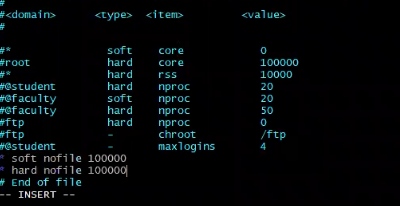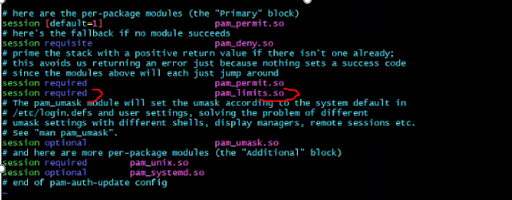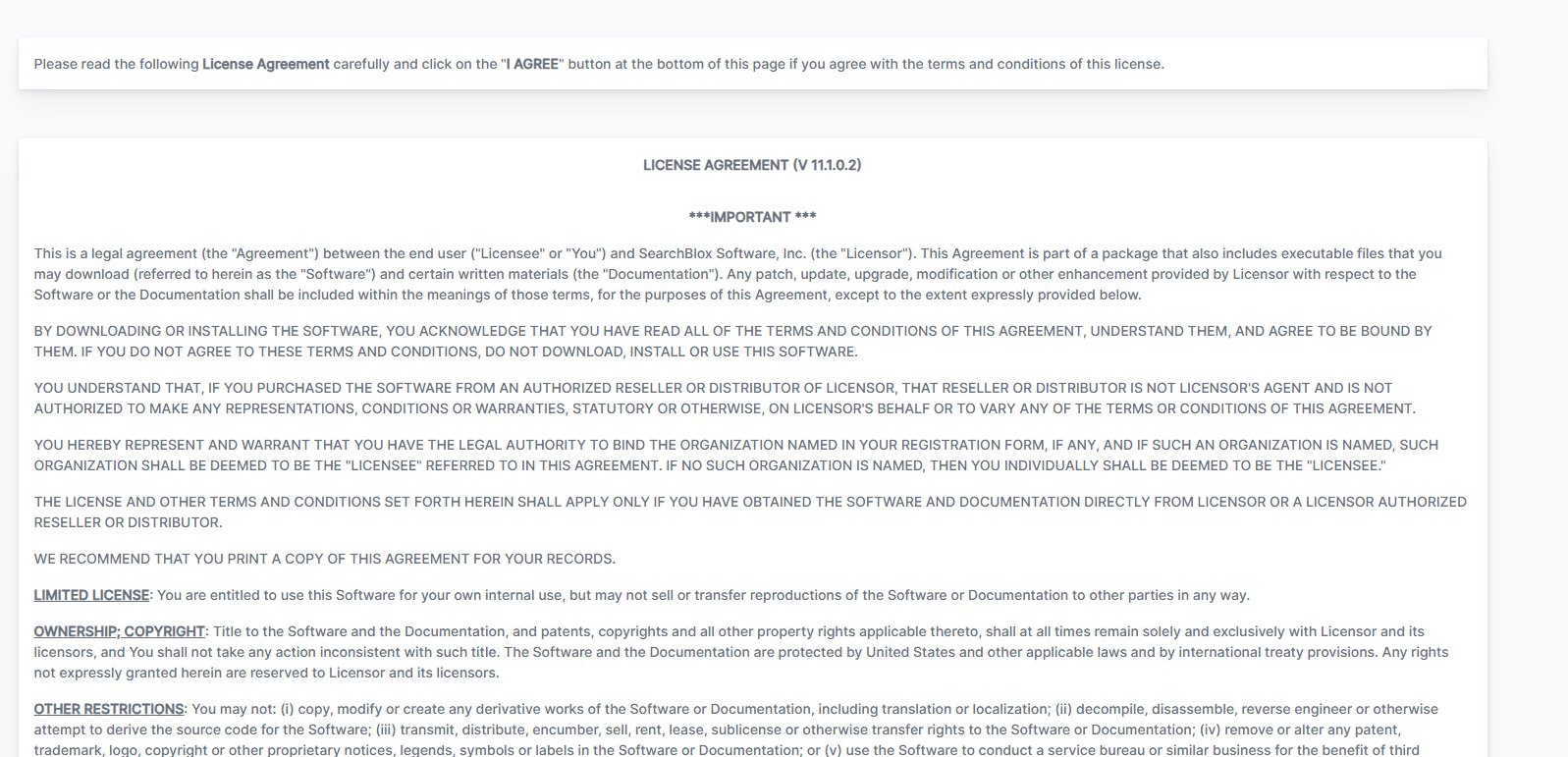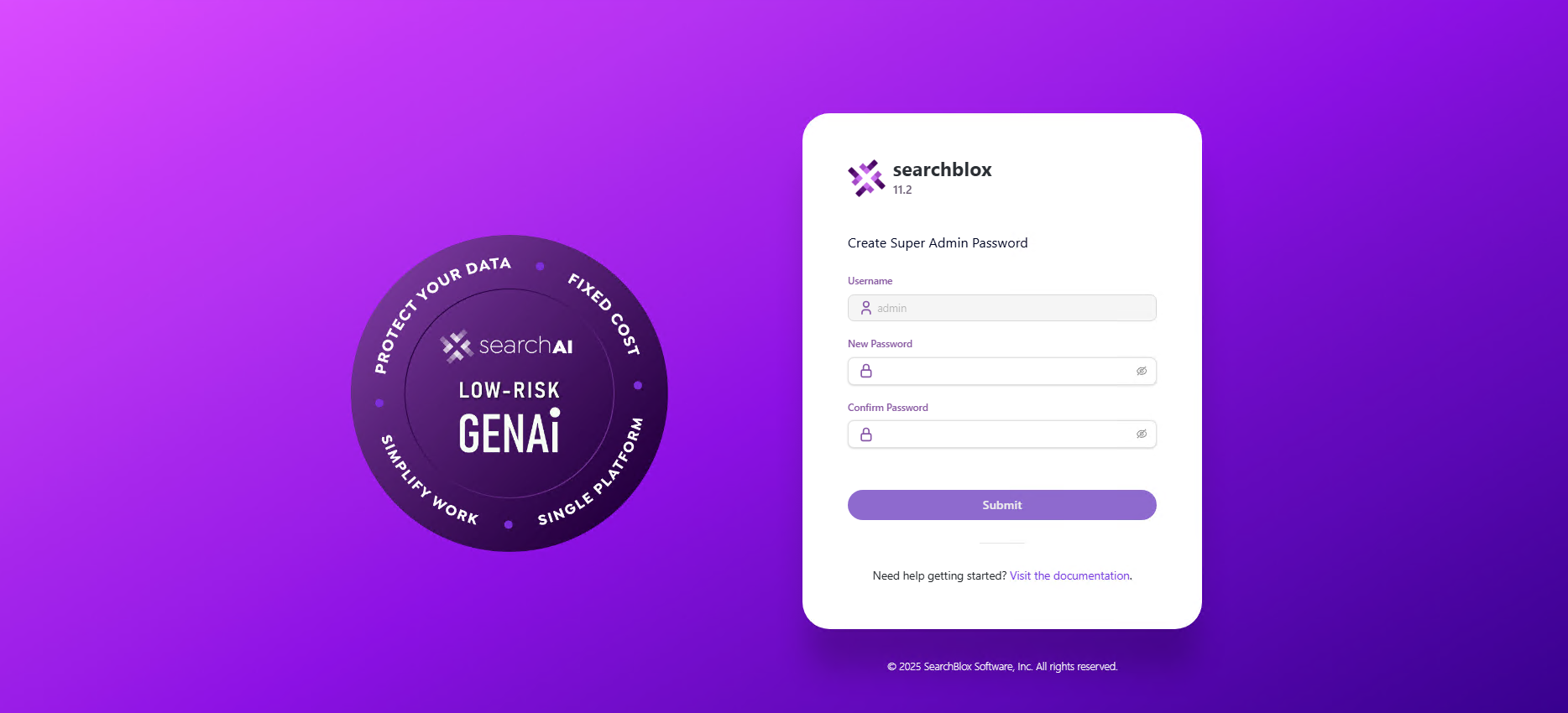Installing on Ubuntu
This guide details the prerequisites and steps to install SearchBlox on Ubuntu
To install SearchBlox on Ubuntu, follow the steps below to set up the prerequisites and configure the system for optimal performance. This guide assumes you are using an EC2 instance or a similar Ubuntu environment.
Prerequisites
-
Install OpenJDK 21:
SearchBlox requires Java to run. Install OpenJDK 21 using the following commands:sudo apt install openjdk-21-jdkVerify the Installation:
java -versionEnsure the output shows OpenJDK 21.
-
Install wget:
wget is required to download files from the internet. Install it using:sudo apt-get update sudo apt-get install wget -
Install Dependencies for Dynamic Auto Collection Crawler:
Install the following libraries:sudo apt-get install libxkbcommon0 libgbm1 -
Set vm.max_map_count:
Edit the/etc/sysctl.conffile to set thevm.max_map_countvalue:sudo vi /etc/sysctl.confAdd the following line:
vm.max_map_count=262144Apply the changes:
sudo sysctl -p -
Increase File Descriptor Limit:
Edit the /etc/sysctl.conf file to increase the file descriptor limitsudo vi /etc/sysctl.confAdd the following line:
fs.file-max=100000Apply the changes:
sudo sysctl -p

- Set ulimit Values:
Edit the /etc/security/limits.conf file to set soft and hard limits:Add the following linessudo vi /etc/security/limits.conf* soft nofile 100000 * hard nofile 100000
- Enable pam_limits
Edit the /etc/pam.d/common-session file:Add the following linesudo vi /etc/pam.d/common-sessionsession required pam_limits.so


- Reboot the Server:
Reboot the server to apply all changes:sudo reboot - Verify ulimit Settings:
After rebooting, verify the ulimit settings:ulimit -a ulimit -Sn # Check soft limit ulimit -Hn # Check hard limit
SearchBlox Installation
-
Login as Root:
If you are not the root user, switch to the root usersudo su -
Create a SearchBlox User:
Create a dedicated user for SearchBlox. Follow the prompts to set a password and provide necessary details.sudo adduser searchblox -
Navigate to the /opt Directory:
SearchBlox must be installed in the /opt folder. Change to the /opt directory:cd /opt -
Download the SearchBlox Debian Package:
Download the SearchBlox Debian package using wget:sudo wget https://d2fco3ozzrfhhd.cloudfront.net/v11.2/searchblox_11.2-0_all.deb -
Install the Debian Package:
Install the downloaded package using dpkg:sudo dpkg -i searchblox_11.2-0_all.deb
-
Set Permissions:
Change ownership and permissions for the SearchBlox directories:sudo chown -R searchblox:searchblox /opt/searchblox sudo chmod -R 755 /opt/searchblox/bin sudo chmod -R 755 /opt/searchblox/opensearch/ sudo chmod -R 755 /opt/searchblox/logs sudo chmod -R 755 /opt/searchblox/connectors -
Install and Run SearchAI PrivateLLM:
Follow the instructions in the SearchAI PrivateLLM documentation to install and run theSearchAI PrivateLLMandollama.service.
Optional : If you want to use SmartSuggest , download the keyphrase model from following link
keyphrase.zip
Extract the downloaded keyphrase_extractor.zip file and place it inside<SearchBlox-Installation-Path>/webapps/ROOT/models -
Start the SearchBlox Service:
Start the SearchBlox service using systemctl:systemctl start searchblox -
To stop SearchBlox service, use
systemctl stop searchbloxTo Check the Status of the SearchBlox Service:
systemctl status searchblox
Troubleshooting
- Installation Errors:
If the dpkg installation fails due to missing dependencies, run:sudo apt-get install -f
Then retry the installation:sudo apt-get install -f sudo dpkg -i searchblox_11.2-0_all.deb
- Service Not Starting:
Check the logs for errors:Ensure all prerequisites (e.g., Java, file permissions) are correctly configured.journalctl -u searchblox - Port Conflicts:
Ensure port 8443 is not being used by another application. You can check using:sudo netstat -tuln | grep 8443
Verify Installation
-
Access the SearchBlox Admin Console:
Wait for 30-60 seconds after starting the SearchBlox service.
Open a web browser using the end point:https://<localhost or IP>:8443/console
-
Log in to the Admin Console:
Setup the Super Admin Password.
Login using the updated username and password.

-
Verify the Service Status:
If the Admin Console loads successfully, the SearchBlox service is running correctly.
Check the Status Log File
- Navigate to the Logs Directory:
The status log file is located at:
/opt/searchblox/webapps/ROOT/logs/status.log
- View the Log File:
Use the following command to view the log:
cat /opt/searchblox/webapps/ROOT/logs/status.log
- Confirm Successful Startup:
Look for the message:
SearchBlox Started
- Troubleshoot Errors:
If the service fails to start, the status.log file will contain error messages or warnings that can help identify the issue.
Common issues include:- Port conflicts (ensure port 8443 is free).
- Incorrect file permissions (verify permissions for /opt/searchblox).
Verify that the /opt/searchblox directory and its subdirectories have the correct permissions:sudo chown -R searchblox:searchblox /opt/searchblox sudo chmod -R 755 /opt/searchblox - Missing dependencies (ensure Java and other prerequisites are installed).
Additional Resources
-
To learn more on Troubleshooting visit: Logging and Troubleshooting
-
To learn about accessing SearchBlox visit: Overview of SearchBlox
-
To learn about tuning after installation visit: Installation Tuning
SearchBlox Admin Console Access using IP Address or Domain Name
- Using IP Address:
Replace localhost with your server's IP address in the URL:https://<your-server-ip>:8443/console- Using Domain Name:
If a domain name is mapped to your server's IP address, use the domain name in the URL:https://exampledomain:8443/console
Important Notes
- Port Number: By default, SearchBlox uses port 8443. Ensure this port is open and accessible in your firewall or security group (if using a cloud instance like AWS EC2).
- HTTPS: SearchBlox uses HTTPS for secure communication. Ensure your browser trusts the SSL certificate (self-signed certificates may require manual approval).
- Domain Configuration: If using a domain name, ensure the DNS records are correctly configured to point to your server's IP address
Steps to Install and Run SearchAI PrivateLLM
To install and run SearchAI PrivateLLM after completing the SearchBlox installation, follow the steps below. This process involves downloading the PrivateLLM Models, setting up the ollama.service, and starting the service.
- Download the Models Folder:
Download the PrivateLLM Models from the provided link:
SearchAI PrivateLLM Models
Extract the downloaded models folder. - Replace the Models Folder:
Navigate to the /opt/searchblox/ollama/models directory and replace the existing models folder with the downloaded one.cd /opt/searchblox/ollama/models - Create the ollama.service File:
- Navigate to the /etc/systemd/system/ directory:
cd /etc/systemd/system/- Create a new service file named ollama.service:
sudo vi /etc/systemd/system/ollama.service
Add the following script to the ollama.service file:
[Unit]
Description=Ollama Service
After=network-online.target
[Service]
WorkingDirectory=/opt/searchblox/ollama/bin
ExecStart=/opt/searchblox/ollama/bin/ollama serve
User=root
Group=root
Restart=always
RestartSec=3
Environment="OLLAMA_MODELS=/opt/searchblox/ollama/models/"
[Install]
WantedBy=default.target
Then save and exit the file.
- Set Execute Permissions:
Provide execute permissions for the ollama.service file:Also, set execute permissions for the ollama binary:sudo chmod 755 /etc/systemd/system/ollama.servicesudo chmod 755 /opt/searchblox/ollama/bin/ollama
- Reload Systemd Daemon:
Reload the systemd daemon to apply the new service file:sudo systemctl daemon-reload - Start the Ollama Service:
sudo systemctl start ollama - Verify the Models:
Check the list of available models by running:./opt/searchblox/ollama/bin/ollama list - Download the Model:
Download the model using the command below:./opt/searchblox/ollama/bin/ollama pull qwen2.5 - Stop the Ollama Service (Optional):
To stop the ollama service, use:sudo systemctl stop ollama - Enable Auto-Start on Reboot:
To ensure the ollama service starts automatically on system reboot, enable it:sudo systemctl enable ollama
Change SearchBlox Server Port
To change the SearchBlox Server port from the default 8443 to a different port (e.g., 443), follow the steps below. This process involves editing the configuration file and restarting the SearchBlox service.
-
Stop the SearchBlox Service:
sudo systemctl stop searchblox -
Edit the https.ini File:
Open the https.ini file located in the /opt/searchblox/start.d/ directory:sudo vi /opt/searchblox/start.d/https.ini -
Set the New Port Number:
Add or update the following line in the https.ini file to specify the new port number. Replace 443 with your desired port number.jetty.ssl.port=443 -
Start the SearchBlox Service:
sudo systemctl start searchblox -
Verify the New Port:
Wait for 30-60 seconds, then access the SearchBlox Admin Console using the new port:https://<your-server-ip>:443/consoleReplace 443 with the port number you configured.
Important Notes
Secure Ports: Ensure the new port is a secure port (e.g., 443 for HTTPS). Refer to the Secure Ports used by SearchBlox section for more details.
Firewall Configuration: If using a firewall or cloud security group, ensure the new port is open for inbound traffic.
Port Conflicts: Verify that the new port is not already in use by another application. You can check using:
sudo netstat -tuln | grep <port-number>
Port Update
Fix the permission denied error while using searchblox service on less than ports 1024, run the below commands:
Check the Java Path
readlink -f $(which java)Set the capability to bind low ports for non-root searchblox user.
setcap cap_net_bind_service+ep <javapath>
Uninstall
-
First Stop the SearchBlox, by running the command:
systemctl stop searchblox -
Run the following command to uninstall or remove SearchBlox:
apt-get remove searchblox -
To remove the user, run the command;
userdel searchblox -
Reboot the server:
reboot
Note: For clean SearchBlox uninstallation, it is required to remove searchblox directory i.e., /opt/searchblox manually by running the following command:
rm -rf /opt/searchblox
Disk Encryption
Additional Disk is required for disk encryption
-
Installation of
cryptsetupfor Ubuntu:
sudo apt-get install cryptsetup -
LUKS Format disk
Note: while formatting the disk we have to give some password
cryptsetup luksFormat /dev/sdb
WARNING!
========
This will overwrite data on /dev/sdb irrevocably.
Are you sure? (Type uppercase yes): YES
Enter LUKS passphrase:
Verify passphrase:
- Luks open
Note: We have to use the password created earlier while formatting the disk.
cryptsetup luksOpen /dev/sda data
Enter passphrase for /dev/sdb:
- Create a filesystem
mkfs -t ext4 /dev/mapper/data
mke2fs 1.42.13 (17-May-2015)
Creating filesystem with 52428288 4k blocks and 13107200 inodes
Filesystem UUID: 1c71b0f4-f95d-46d6-93e0-cbd19cb95edb
Superblock backups stored on blocks:
32768, 98304, 163840, 229376, 294912, 819200, 884736, 1605632, 2654208,
4096000, 7962624, 11239424, 20480000, 23887872
Allocating group tables: done
Writing inode tables: done
Creating journal (32768 blocks): done
Writing superblocks and filesystem accounting information: done
- Mounting the new file system at /opt
mount /dev/mapper/data /opt - To get UUID
blkid /dev/mapper/data
/dev/mapper/data: UUID="0a228c13-06d8-4739-99c3-f596c2dcce8e" TYPE="ext4"
- We need to add the UUID into
/etc/fstablike this and save it
Note: We need to add the UUID intoetc/fstabfile
LABEL=cloudimg-rootfs / ext4 defaults,discard 0 0
UID="4539b70d-66ab-4c07-b2a2-d4583f461a2f" /secret ext4 defaults 0 0
UID="4539b70d-66ab-4c07-b2a2-d4583f461a2f" /opt ext4 defaults 0 0
UUID="0a228c13-06d8-4739-99c3-f596c2dcce8e" /opt ext4 defaults 0 0
===================================================
- To close encryption
cryptsetup luksClose /dev/mapper/data - To open encryption
cryptsetup luksOpen /dev/mapper/data
NOTE:
If you face any trouble in starting opensearch and in logs if you find the error as
Opensearch status REDfollow the steps given here:
- Set the
OPENSEARCH_JAVA_HOMEby running the following command:- If you have installed java from
Prerequisitessection, use the below command:export OPENSEARCH_JAVA_HOME=/usr/lib/jvm/java-21-openjdk-amd64- If java is installed in different path, change the value.
export OPENSEARCH_JAVA_HOME=<java installation path>
Updated 4 months ago
